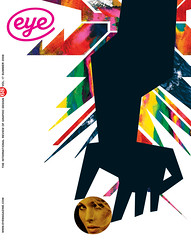Summer 2008
Dieter Wiechmann
Who cares about graphic design history?

Originally from Germany, Dieter Wiechmann graduated from the Parsons School of Design, New York, in 2001.
Q1. What do you think is meant by ‘the canon of graphic design history’? Do you buy design history publications?
A1. The canon is a list of visual icons. Their importance becomes apparent when they are studied in context. Things that end up in the canon are there not because of their aesthetics but because of the spirit in which they were made, and what they were created in reaction to. They mark the points in time where the rules of the game where changed.
I don’t buy design history books!
Q2. Does design history have relevance to your practice?
A2. Not really. But I have studied design history, so I am probably always aware of it when working on ideas.
Q3. Where did you learn about design history?
A3. While studying at Parsons School of Design in New York, there were design history requirements to be fulfilled. But I learned more on my own while working –- looking at art and design as a way to understand the context of my own work.
Q4. Does history have relevance to the new technology and techniques you’ve had to master in your work?
A4. In terms of production, yes. The way things look in all aspects of design is a direct result of the technology used to produce them. An understanding of the technology and its history allows for a better control of what the final product is going to look and feel like.
Q5. If you were in charge of a design education programme, what aspects of design history would you teach?
A5. Design history is important in terms of being aware of how the field has got to where it is and why. But I would put a strong emphasis on design history as a series of shifts in ideology that occur in design as well as art, literature, technology, politics, etc. It was the constant reassessment of the norms that put things in the canon, and not just the aesthetics.
I would also push students to challenge design history. Just because it is in the books doesn’t make it good. There is a timeline of design that should be taught, but design history should be a discussion or a debate rather than a rulebook.
I would also open up the dialogue to analysing the visual culture that surrounds us on a day-to-day basis. Brands and their products are completely intertwined in our life. This constant visual bombardment has a much deeper effect on us than the canon of graphic design history.
Top: EP Cover at for Skintrax records. Design: Dieter Wiechmann, 2008.
First published in Eye no. 68 vol. 17 2008
Eye is the world’s most beautiful and collectable graphic design journal, published quarterly for professional designers, students and anyone interested in critical, informed writing about graphic design and visual culture. It is available from all good design bookshops and online at the Eye shop, where you can buy subscriptions and single issues.

